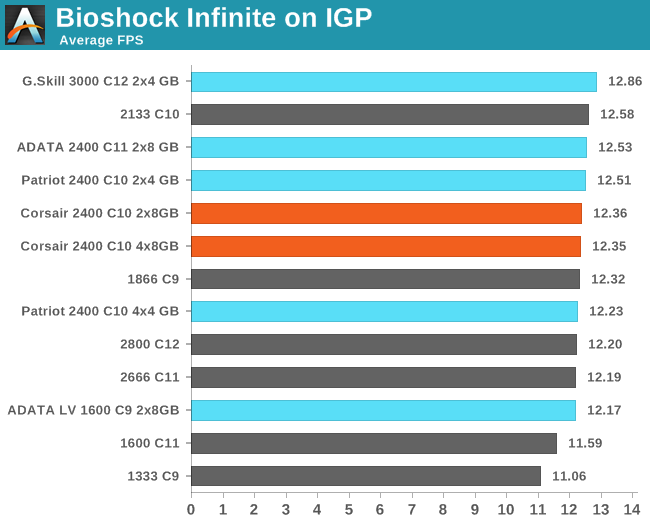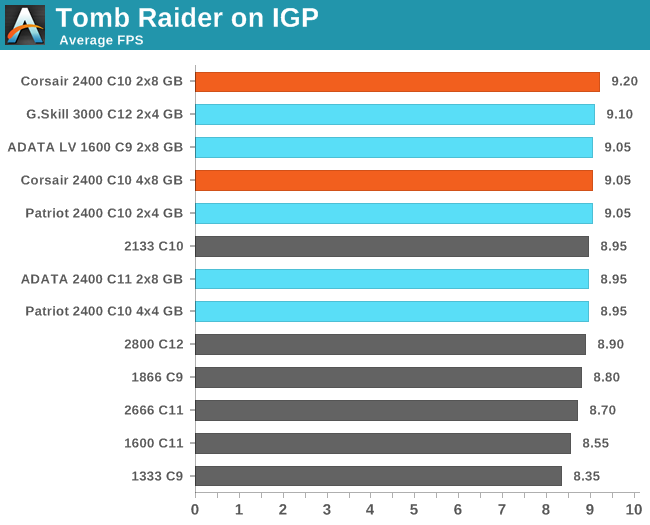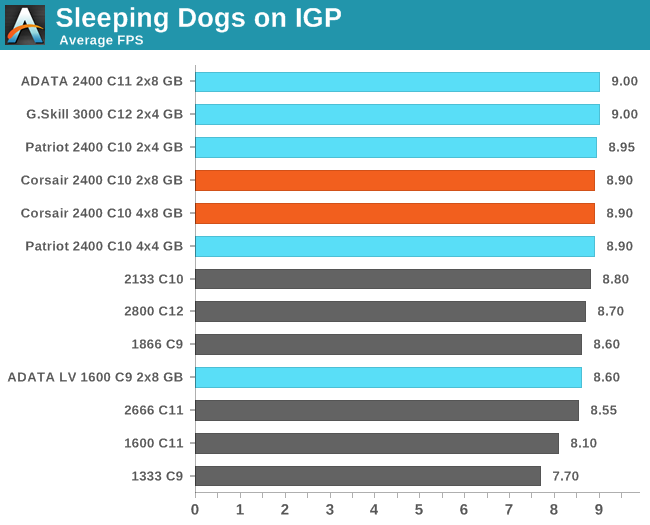Corsair Vengeance Pro Review: 2x8 GB at DDR3-2400 10-12-12 1.65 V
by Ian Cutress on December 13, 2013 2:00 PM ESTIGP Gaming
The activity cited most often for improved memory speeds is IGP gaming, and as shown in both of our tests of Crystalwell (4950HQ in CRB, 4750HQ in Clevo W740SU), Intel’s version of Haswell with the 128MB of L4 cache, having big and fast memory seems to help in almost all scenarios, especially when there is access to more and more compute units. In order to pinpoint where exactly the memory helps, we are reporting both average and minimum frame rates from the benchmarks, using the latest Intel drivers available. All benchmarks are also run at 1360x768 due to monitor limitations (and produces more relevant frame rate numbers).
Bioshock Infinite:

No real average frame rate difference on IGP with Bioshock Infinite - we avoid the 1333 C9/1600 C11 pitfalls. On minimum frame rates however, the inclusion of more memory takes a hit here.
Tomb Raider:

The Corsair kit takes the top spot for Tomb Raider on IGP, both in average and minimum frame rates, despite the overall differences being relatively small.
Sleeping Dogs:

Sleeping Dogs is very consistent - again we avoid the low PI pitfalls at the bottom of the graphs.










26 Comments
View All Comments
Hairs_ - Saturday, December 14, 2013 - link
A crossfire test is absolutely a valid metric, and testing with older generations of cpu and gpu is something I'm wholly in favour of. My issue is that if someone was buying a dual gpu setup, they would match the cards. If they upgraded after a time differential due to a budget concern, they might mix generations. I don't see a scenario where someone is buying dual+single, however, because if you had the budget to go for a top of the line dual card, you'd be better off with two cheaper cards in crossfire.Would people still have 4 gen old setups? Absolutely! Would they mix and match cards to suit a tight budget? Sure. Would any retail buyer follow *this* pattern? Vanishingly unlikely.
Egg - Sunday, December 15, 2013 - link
Wait, why wouldn't you use a 5970 and a 5870? Sure you lose a bit on clock speeds but it's exactly the same as triple 5870 otherwise, isn't it? And you save some slots.Perhaps someone wanted to do a really expensive water cooled microATX build with 4 slots. IDK, but it doesn't sound that farfetched in practice.
I haven't done this, or CF'ed anything at all, so this is just my two cents...
Hairs_ - Sunday, December 15, 2013 - link
Why? Like I said, there's no physical reason why you *couldn't*, but people use crossfire/sli for the same reason people overclock: to get top-line performance out of a smaller budget. The other use scenario is someone who wants bragging rights and doesn't care about the cost.For the primary, that user is not going to pay for a top line dual card when they could get similar numbers from two lower end cards. For the secondary use case, if money is no object (which it would have to be), why wouldn't you have bought two 5970's?
This example doesn't fit into any consumer behavior, so I have no idea why it would be used as a test.
Giffs - Friday, December 13, 2013 - link
No idea if there is any point in using winrar 4.2But there is winrar 5.01 why not using the latest version? wouldn't it bring improvements on the software side and more accurate results of some sorte??
sinPiEqualsZero - Saturday, December 14, 2013 - link
Thanks for the writeup. I'm shopping for memory and am happy I got to read this first.Also, I noticed an issue: " More expensive kits do not always equal performance, and as our benchmarks go, higher specification kits might also have little affect" should be effect with an e.
Thanks, Ian!
Hairs_ - Saturday, December 14, 2013 - link
There's no "might" about it. High spec kits make NO difference.Hairs_ - Saturday, December 14, 2013 - link
I wonder how it is that the entirely arbitrary "Performance Index" which was devised for memory testing isn't at all borne out by real-world data. Yet the bald statement"From the data in our memory overview, it was clear that any kit with a performance index of less than 200 was going to have issues on certain benchmarks. The Corsair kit has a PI of 240, which is at the higher end of the spectrum."
is still maintained.
There are no facts to back this statement up, as proved in the tests. Are Anandtech reviews going to continue to ignore factual data in favour of preconceived assumptions? I hope not.
Ytterbium - Saturday, December 14, 2013 - link
Explicit Finite Difference, in this graph you have 1333 C9 mid pack and 1866 C9 at bottom, I assume this is typo?Hairs_ - Saturday, December 14, 2013 - link
if you look at all the graphs, the results aren't consistent at all. The kit that top one graph can be bottom of the next. Furthermore, the differences between top and bottom scoring kits is negligible in almost all tests, so many of the differences in rank can be due to statistical variance rather than a meaningfully measured performance difference.E.g. in many tests, the fastest kit in terms of headline mhz (3ghz) is beaten by theoretically slower stuff.
Gen-An - Saturday, December 14, 2013 - link
I wonder if Corsair has purposely set out to make this kit look bad. Every single review I've seen of the Vengeance Pro 2x8GB 2400C10 kit has been Ver4.21, which uses Samsung 4Gbit B-die ICs and are infamous for not being able to clock much higher than about DDR3-2500 or so. I have four sticks of these and they are Ver5.29 using Hynix 4Gbit MFR and I've done Super Pi 32M runs at DDR3-3000 12-15-15-45 and they are rock solid at DDR3-2666 11-13-13.